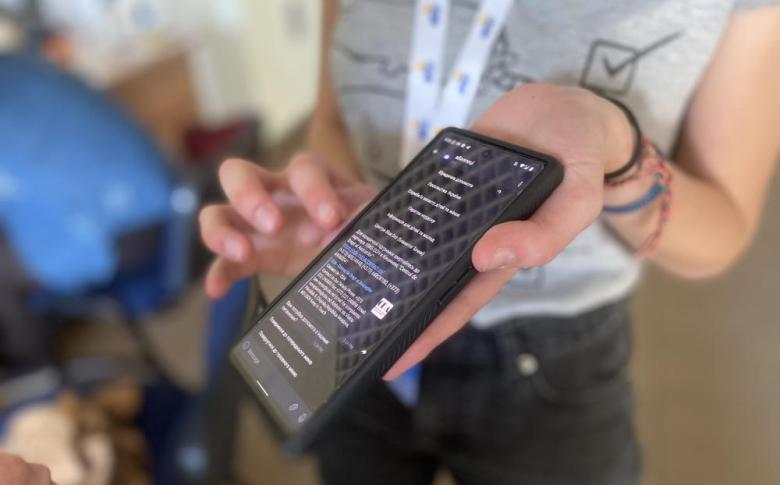Introducing the new ETC Chatbot: An AI-powered 'buddy' in times of crisis

This story originally appeared on WFP Digital.
By Lena Bock
----
In times of crisis, when people are most vulnerable, access to life-saving information is often elusive. The Emergency Telecommunications (ETC) Chatbot, a groundbreaking solution piloted in 2021, aimed to bridge this gap by providing affected populations with critical information about humanitarian responders' offerings and services.
Now, a new iteration of the ETC Chatbot, enabled by artificial intelligence (AI), goes beyond providing information - it builds trust through communication to truly understand the needs of those affected by crisis, enabling humanitarian responders to become more effective than ever.
The magic behind the new chatbot will lie in its cognitive capabilities, leveraged by generative AI and Large Language Models (LLM), enabling the chatbot to understand and respond to human emotions and needs effectively. This will not just be a machine giving out information―it will be a companion that cares.

Cognitive chatbot brings a human touch in dire situations
At the heart of the cognitive, the AI-enabled ETC Chatbot solution will lie a revolutionary approach: two-way communication. This interactive feature will allow affected individuals to receive information and share their feedback and concerns. The chatbot will become more than just a source of information sharing and data collection: it will be a "buddy," offering a human touch in emergencies where people feel helpless.
The magic behind the new chatbot will lie in its cognitive capabilities, leveraged by generative AI and Large Language Models (LLM), enabling the chatbot to understand and respond to human emotions and needs effectively. This will not just be a machine giving out information―it will be a companion that cares.
In emergencies, gathering feedback is crucial. With its power to act as a feedback mechanism, the ETC Chatbot solution enables emergency responders to adapt to changing needs in different emergency contexts over time. By continuously improving and refining its responses, the chatbot will become a more reliable source of information and support, ultimately supporting those in need more efficiently.
A first iteration of the ETC Chatbot was first rolled out in 2021 and has been used in Libya, Iraq, Ecuador, and, more recently, in Ukraine, where it was known as 'vBezpetsi' (safe spaces). vBezpetsi connected people fleeing the war with humanitarian assistance and helped them understand their rights. At the start of the conflict, it was a critical tool in aggregating information from humanitarian partners on cash assistance, protection, health, shelter, education, and job opportunities while providing up-to-date information on how and where to get help.

Harnessing AI for an adaptive user experience
In 2021, when the ETC first launched its chatbot, AI was still emerging. Today, with ChatGPT and Bard, the global AI landscape has evolved dramatically. One of the key drivers behind innovating the ETC Chatbot was to harness AI's potential for better connections with people during disasters. This includes providing personalized responses and enabling them to have conversations and enjoy a more engaging user experience compared to the experience of using static dropdown menus.
Deploying a chatbot in sudden onset emergencies and challenging contexts such as Ukraine enabled the ETC to consider how the chatbot could be more effective. In response, the new AI-enabled chatbot is a no-code solution manageable by non-technical staff to mitigate reliance on scarce technical resources—especially when the response community is immersed in disaster response.
Further, maintaining a balance in the chatbot's conversation style is crucial. The new chatbot aims to be factual yet engaging, adapting to users' conversational levels for a resonant experience, avoiding extreme creativity while fostering trust.

From innovation to scale with Google
The new iteration of the ETC Chatbot has been selected to participate in the WFP Humanitarian Accelerator program, an initiative supported by the WFP Innovation Accelerator and Google for Startups. This program will facilitate and help scale ten innovative ideas across all WFP offices.
Equipped with financial resources and benefiting from Google's business and technical expertise, the Global ETC team can now bring the new chatbot to fruition.
The program kicked off on 29 January with an intensive four-day boot camp in close collaboration with Google at WFP's Innovation Accelerator offices in Munich. The first phase will run until June, potentially extending participation into a scaling phase until the end of December 2024.
In a world where AI is increasingly prevalent, the ETC Chatbot can be a light of hope for those in crisis and an illustration of the power of technology in making humanitarian response more effective and compassionate.
Looking ahead: a two-way street to compassionate assistance and a brighter future
The ETC Chatbot has the potential to extend its impact beyond crisis response. In emergency preparedness contexts in high-risk countries, it can educate populations about risks and necessary actions, enhancing resilience and empowerment.
The ETC is dedicated to sustaining two-way communication with affected populations, prioritizing honest and valuable feedback. This builds trust, empowers individuals, and ensures they receive the necessary information. The goal is to go beyond providing assistance to those in need but to foster a sense of community and support during people's darkest hours.
In a world where AI is increasingly prevalent, the ETC Chatbot can be a light of hope for those in crisis and an illustration of the power of technology in making humanitarian response more effective and compassionate.